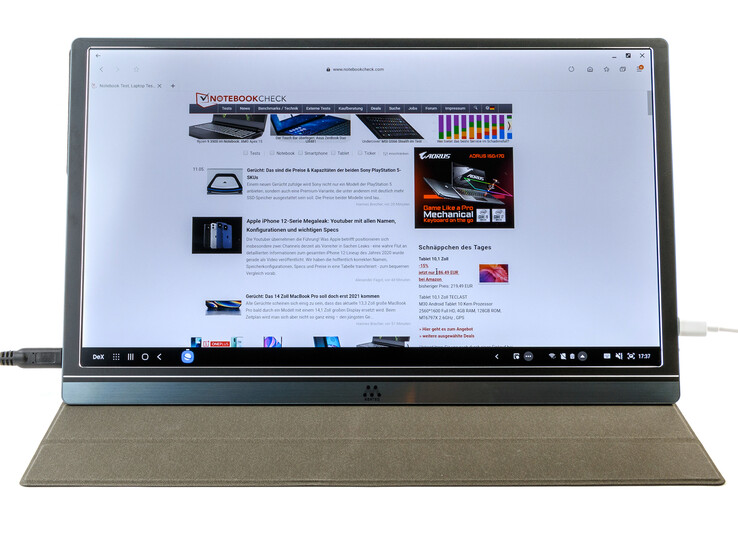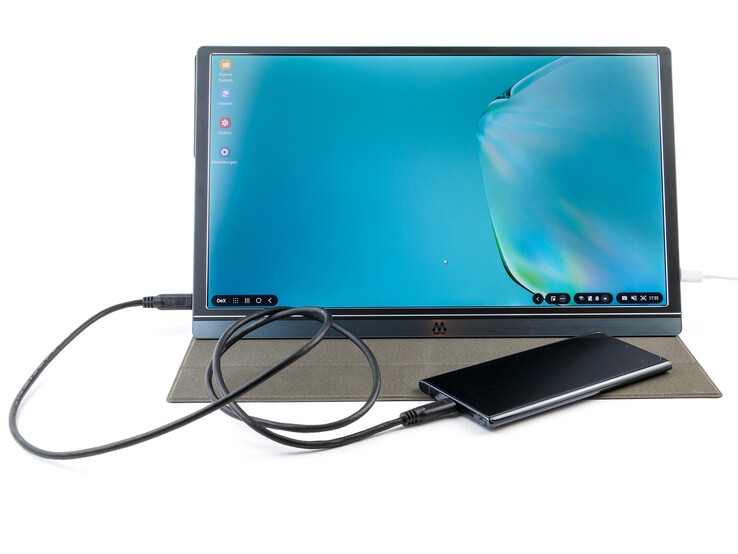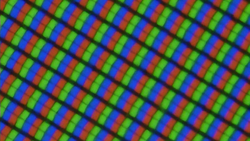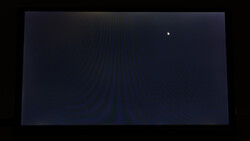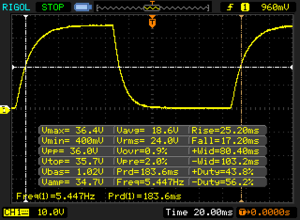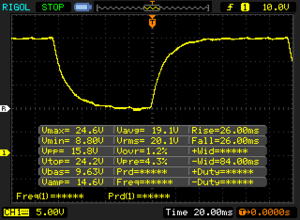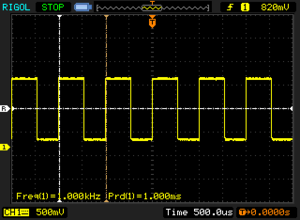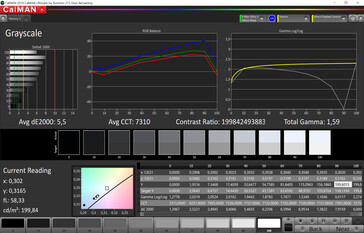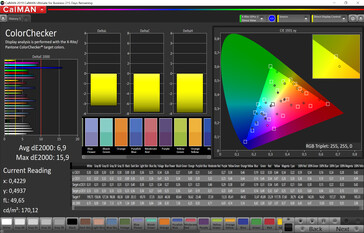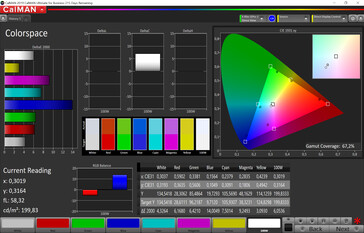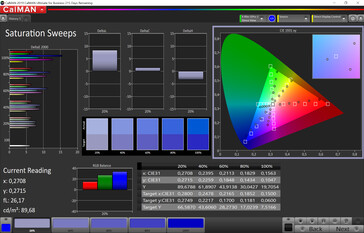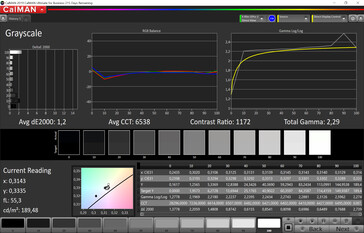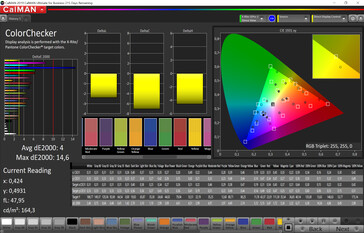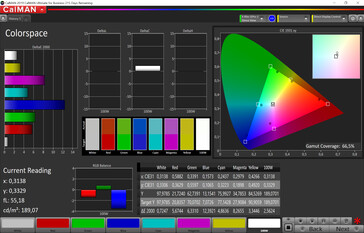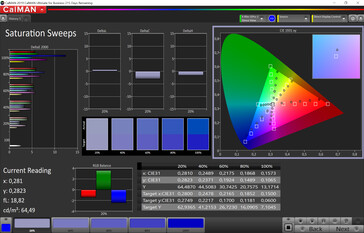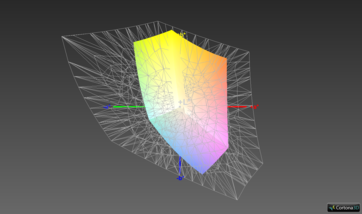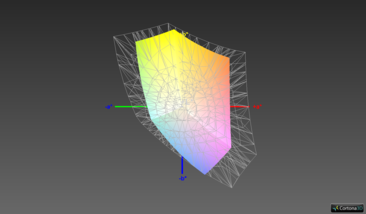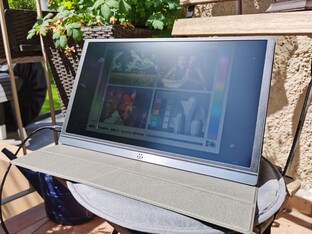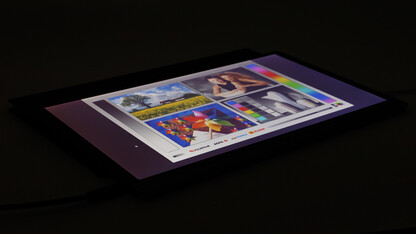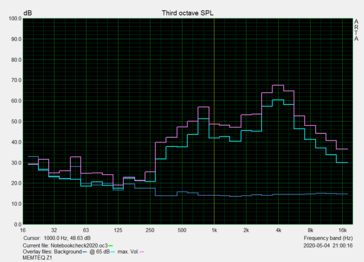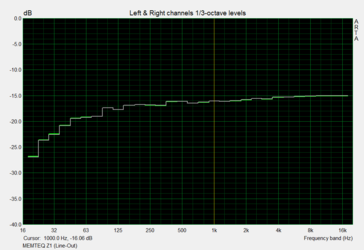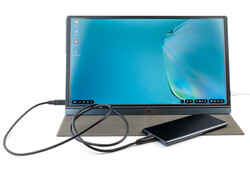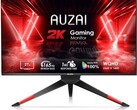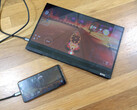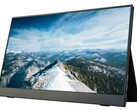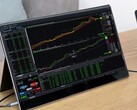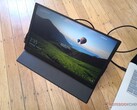M MEMTEQ Type-C Portable Monitor Z1 review - Multi-screen use on the go
Date | Model | Weight | Height | Size | Resolution | Price |
|---|---|---|---|---|---|---|
05 / 2020 | MEMTEQ Type-C Portable Monitor Z1 | 770 g | 8.8 mm | 15.60" | 1920x1080 | |
09 / 2019 | MageDok Atlas Gaming Monitor | 1 kg | 8.7 mm | 15.60" | 1920x1080 | |
01 / 2020 | Auzai ME16Z01 Portable Monitor | 650 g | 9.4 mm | 15.60" | 1920x1080 | |
| Asus MB16AC | 780 g | 8 mm | 15.60" | 1920x1080 |
Case, equipment and commissioning
The portable monitor consists of a thin aluminum unibody; only the frame of the display is made of plastic, just like the OSD rocker and the confirmation switch. Due to the flat design, the monitor can be twisted quite easily but is overall quite stable. The workmanship looks solid and clean, but the choice of materials does not leave a particularly valuable impression. Connected cables always protrude a little from the socket, but we were not able to provoke signal errors.
The equipment of the MEMTQ Z1 is quite decent. In addition to the mini HDMI interface there is a jack socket and two USB-C ports. However, only the USB port on the left can be used as an image input, the other is reserved for the optional power supply.
The OSD rocker is not exactly premium quality, but it does the job and responds reliably. To start the menu, the rocker must be pressed, and by doing so it sinks almost completely into the housing.
Either mini-HDMI or USB-C is available for incoming picture signals. If you choose the former, you have to connect the monitor to an external power source; this does not have to be done via USB, even if only a smartphone is connected. Anyone who supplies the M MEMTEQ Z1 with additional power can charge the smartphone directly.
Commissioning was easy in the test on both the laptop and smartphone - plug in, done. If you calibrate the monitor, you can also save a corresponding profile for it, which is used as soon as it is connected to the computer. Upright use is also possible. A smartphone connected to the Z1 must also support image output via the USB connection. We successfully tested it with both the Samsung Galaxy Note10+ and the Huawei Mate 30 Pro. For both smartphones a simple screen-mirroring function as well as a desktop mode was available. If you want to connect an iPhone to it, you will need an optional adapter.
Accessories and warranty - extensive scope of delivery in the M MEMTEQ Z1
The manufacturer includes a very extensive scope of delivery with its portable monitor. In addition to the screen itself, there is a dust jacket that is magnetically held in place and can be used as a stand (two angles). In addition, two USB cables (Type-A to Type-C and Type-C to Type-C), an HDMI to mini-HDMI cable, a modular power supply (10 watts, 5 V, 2 A, TÜV- / GS seal) as well as a multilingual instruction manual are included.
The 24-month manufacturer's warranty can be extended for another year by registering via email.
Display - Panel cannot achieve the brightness it promises
The portable monitor MEMTEQ Z1 has a matte 15.6-inch panel with a resolution of 1920x1080 pixels. The manufacturer puts the brightness at 300 cd/m², which we cannot confirm with our test device. The display maintains an average of 200 cd/m² and occasionally manages up to 211 cd/m². With a uniform distribution of dark and light areas (APL50), the MEMTEQ Z1 delivers identical measured values as for a full-area display option. An ambient light sensor was not integrated. The monitor has a hard time outdoors and can only be used in the shade at best.
The gaming properties are very limited, because the response times are high, so that streaking can be visible during fast games. In very dark scenes, small light spots can be seen on the edge, but they are not noticeable in everyday life.
Cutbacks must also be made in the working color spaces. While Adobe RGB is only covered by 40%, the much smaller sRGB color space can only be displayed by around 63%. In the factory state, the display is a bit too cool, as the analysis with CalMAN shows. However, a calibration ensures a much better display; especially the grayscale is then mapped almost ideally. The color image is also neat but shows a few outliers, which is due to the reduced color space.
Unfortunately, the monitor uses pulse width modulation for brightness control. Even if the frequency is quite high, sensitive people can still experience issues. The so-called HDR mode brings no visible advantage when playing the corresponding content, which is not surprising given the low maximum brightness. The display can convince with a very good black level and rich contrasts.
| |||||||||||||||||||||||||
Brightness Distribution: 85 %
Center on Battery: 198 cd/m²
Contrast: 990:1 (Black: 0.2 cd/m²)
ΔE ColorChecker Calman: 6.9 | ∀{0.5-29.43 Ø4.77}
calibrated: 4
ΔE Greyscale Calman: 5.5 | ∀{0.09-98 Ø5}
67.2% sRGB (Calman 2D)
62.9% sRGB (Argyll 1.6.3 3D)
40% AdobeRGB 1998 (Argyll 1.6.3 3D)
43.44% AdobeRGB 1998 (Argyll 3D)
63.2% sRGB (Argyll 3D)
42.03% Display P3 (Argyll 3D)
Gamma: 1.59
CCT: 7310 K
| MEMTEQ Type-C Portable Monitor Z1 1920x1080, 15.6" | MageDok Atlas Gaming Monitor 1920x1080, 15.6" | Auzai ME16Z01 Portable Monitor 1920x1080, 15.6" | Asus MB16AC IPS, 1920x1080, 15.6" | |
|---|---|---|---|---|
| Display | 47% | 15% | 3% | |
| Display P3 Coverage (%) | 42.03 | 62.1 48% | 48.53 15% | 43.35 3% |
| sRGB Coverage (%) | 63.2 | 90.7 44% | 72 14% | 64.7 2% |
| AdobeRGB 1998 Coverage (%) | 43.44 | 64.1 48% | 50.2 16% | 44.84 3% |
| Response Times | 77% | 33% | 49% | |
| Response Time Grey 50% / Grey 80% * (ms) | 52 ? | 10.4 ? 80% | 38.8 ? 25% | 19 ? 63% |
| Response Time Black / White * (ms) | 42.5 ? | 11 ? 74% | 25.2 ? 41% | 28 ? 34% |
| PWM Frequency (Hz) | 1000 ? | 4950 ? | 201.6 ? | 25000 ? |
| Screen | -22% | -34% | 93% | |
| Brightness middle (cd/m²) | 198 | 144.9 -27% | 300.7 52% | 166 -16% |
| Brightness (cd/m²) | 198 | 146 -26% | 267 35% | 154 -22% |
| Brightness Distribution (%) | 85 | 91 7% | 77 -9% | 82 -4% |
| Black Level * (cd/m²) | 0.2 | 0.78 -290% | 0.66 -230% | 0.02 90% |
| Contrast (:1) | 990 | 186 -81% | 456 -54% | 8300 738% |
| Colorchecker dE 2000 * | 6.9 | 5.79 16% | 10.26 -49% | 3.51 49% |
| Colorchecker dE 2000 max. * | 15.9 | 8.43 47% | 22.93 -44% | 10.49 34% |
| Colorchecker dE 2000 calibrated * | 4 | 2.12 47% | 5.05 -26% | |
| Greyscale dE 2000 * | 5.5 | 6.7 -22% | 9.5 -73% | 2.49 55% |
| Gamma | 1.59 138% | 1.96 112% | 1.51 146% | 2.38 92% |
| CCT | 7310 89% | 6295 103% | 8200 79% | 6346 102% |
| Color Space (Percent of AdobeRGB 1998) (%) | 40 | 58.2 46% | 45.8 15% | 41 3% |
| Color Space (Percent of sRGB) (%) | 62.9 | 90.7 44% | 71.5 14% | 64 2% |
| Total Average (Program / Settings) | 34% /
3% | 5% /
-16% | 48% /
69% |
* ... smaller is better
Display Response Times
| ↔ Response Time Black to White | ||
|---|---|---|
| 42.5 ms ... rise ↗ and fall ↘ combined | ↗ 25.2 ms rise | |
| ↘ 17.3 ms fall | ||
| The screen shows slow response rates in our tests and will be unsatisfactory for gamers. In comparison, all tested devices range from 0.1 (minimum) to 240 (maximum) ms. » 98 % of all devices are better. This means that the measured response time is worse than the average of all tested devices (20.2 ms). | ||
| ↔ Response Time 50% Grey to 80% Grey | ||
| 52 ms ... rise ↗ and fall ↘ combined | ↗ 26 ms rise | |
| ↘ 26 ms fall | ||
| The screen shows slow response rates in our tests and will be unsatisfactory for gamers. In comparison, all tested devices range from 0.165 (minimum) to 636 (maximum) ms. » 88 % of all devices are better. This means that the measured response time is worse than the average of all tested devices (31.6 ms). | ||
Screen Flickering / PWM (Pulse-Width Modulation)
| Screen flickering / PWM detected | 1000 Hz | ≤ 31 % brightness setting | |
The display backlight flickers at 1000 Hz (worst case, e.g., utilizing PWM) Flickering detected at a brightness setting of 31 % and below. There should be no flickering or PWM above this brightness setting. The frequency of 1000 Hz is quite high, so most users sensitive to PWM should not notice any flickering. In comparison: 53 % of all tested devices do not use PWM to dim the display. If PWM was detected, an average of 8081 (minimum: 5 - maximum: 343500) Hz was measured. | |||
Loudspeaker & jack connection - MEMTEQ Z1 with poor audio performance
The MEMTEQ Z1 monitor has a speaker on each of the two short edges. However, these are not particularly loud nor do they have a satisfactory sound. As the pink noise measurement shows, the frequency curves are very unbalanced.
The integrated audio jack is also only a suboptimal replacement because it is very quiet and cannot output deep tones with full volume.
MEMTEQ Type-C Portable Monitor Z1 audio analysis
(±) | speaker loudness is average but good (72 dB)
Bass 100 - 315 Hz
(-) | nearly no bass - on average 21.8% lower than median
(-) | bass is not linear (15.3% delta to prev. frequency)
Mids 400 - 2000 Hz
(+) | balanced mids - only 3.3% away from median
(±) | linearity of mids is average (12.7% delta to prev. frequency)
Highs 2 - 16 kHz
(±) | higher highs - on average 10% higher than median
(-) | highs are not linear (16.5% delta to prev. frequency)
Overall 100 - 16.000 Hz
(-) | overall sound is not linear (36% difference to median)
Compared to same class
» 94% of all tested devices in this class were better, 1% similar, 6% worse
» The best had a delta of 4%, average was 24%, worst was 134%
Compared to all devices tested
» 94% of all tested devices were better, 1% similar, 6% worse
» The best had a delta of 4%, average was 24%, worst was 134%
MageDok Atlas Gaming Monitor audio analysis
(-) | not very loud speakers (65.5 dB)
Bass 100 - 315 Hz
(±) | reduced bass - on average 8.1% lower than median
(±) | linearity of bass is average (12.1% delta to prev. frequency)
Mids 400 - 2000 Hz
(±) | higher mids - on average 9% higher than median
(±) | linearity of mids is average (14.5% delta to prev. frequency)
Highs 2 - 16 kHz
(+) | balanced highs - only 1.9% away from median
(±) | linearity of highs is average (12.3% delta to prev. frequency)
Overall 100 - 16.000 Hz
(-) | overall sound is not linear (45.6% difference to median)
Compared to same class
» 89% of all tested devices in this class were better, 11% similar, 0% worse
» The best had a delta of 6%, average was 16%, worst was 46%
Compared to all devices tested
» 96% of all tested devices were better, 0% similar, 4% worse
» The best had a delta of 4%, average was 24%, worst was 134%
Pros
Cons
Conclusion - A good addition to the home office
The portable monitor from M MEMTEQ is certainly not an all-rounder for everyone, but it can score in the test with its high-contrast and matte panel. Due to the low color-space coverage and the slow response times, it is not a useful addition for image processing or gaming. However, it is an ideal alternative for office applications or for use with a smartphone.
The portable monitor M MEMTEQ Z1 offers a good display and extensive equipment but promises more than it can deliver.
As the biggest annoyance, the test reveals the non-compliance with the luminosity promise, which is over 30% lower than the manufacturer's stated measurement. The audio properties are also not convincing, neither with the speakers nor with the jack connection. The guarantee can be extended to three years by registering the product.
Behind the company M MEMTEQ is the Lepow company from Hong Kong, which also sells portable monitors under the name Auzai.


